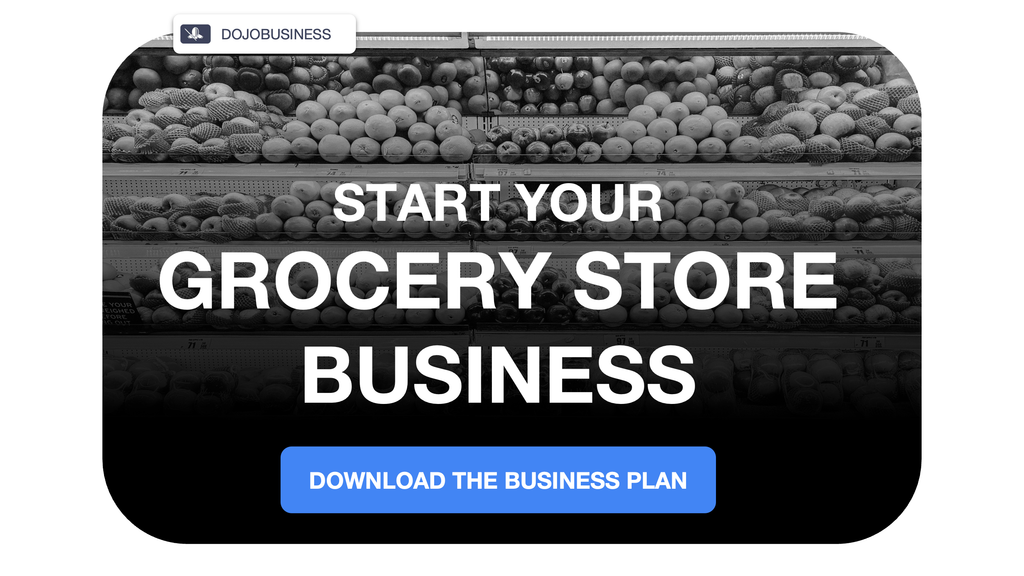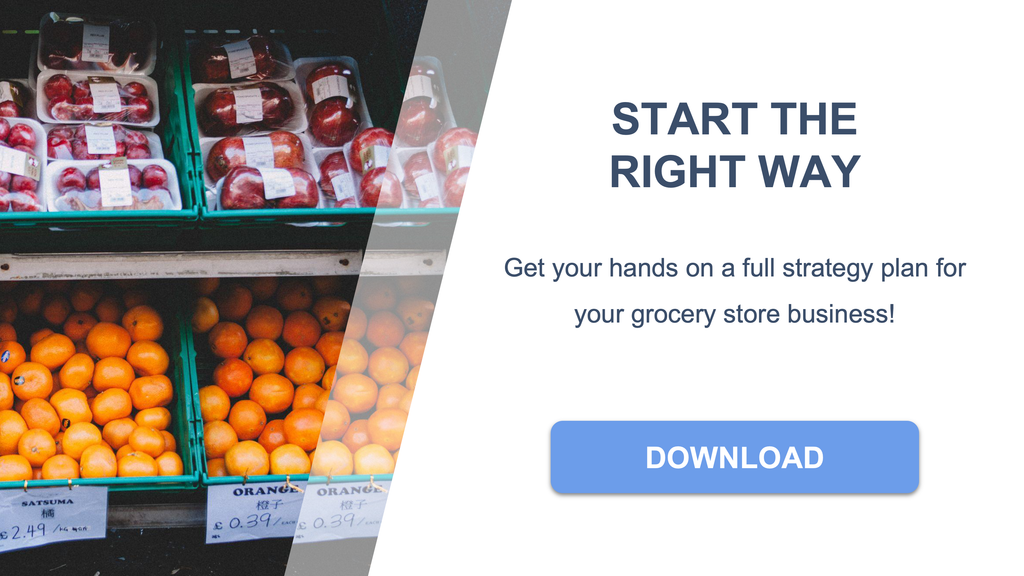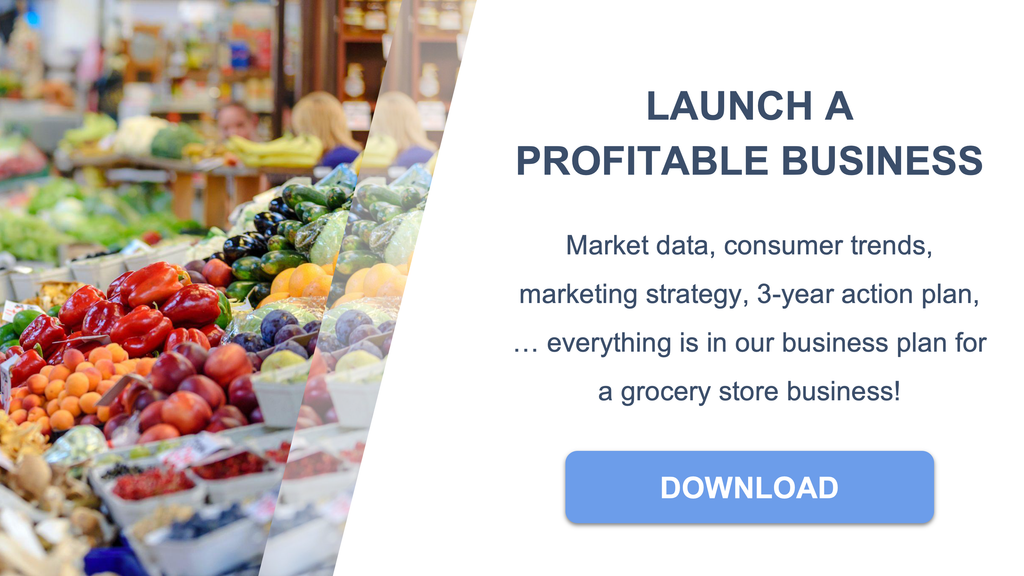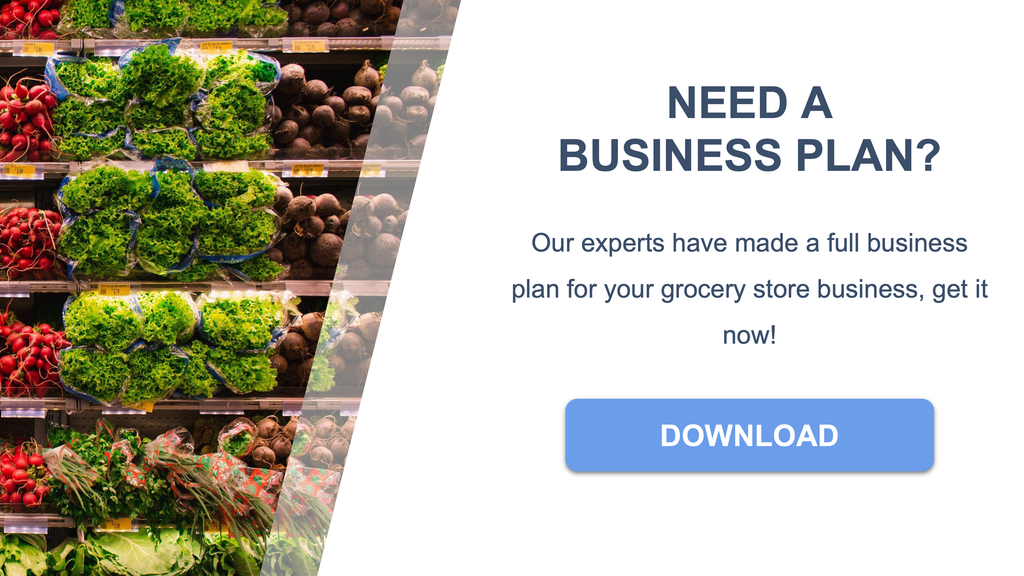This article was written by our expert who is surveying the industry and constantly updating the business plan for a grocery store.

Opening a grocery store requires careful planning across market positioning, location strategy, and financial projections.
This comprehensive guide addresses the twelve most critical questions every grocery store entrepreneur must answer before launch. If you want to dig deeper and learn more, you can download our business plan for a grocery store. Also, before launching, get all the profit, revenue, and cost breakdowns you need for complete clarity with our grocery store financial forecast.
The grocery store market is experiencing steady growth at approximately 3.2% annually, reaching USD 14.8 trillion globally by 2030.
Success requires strategic location selection, differentiated product offerings, and realistic capital planning between USD 250,000 and USD 700,000 for startup costs.
| Key Business Element | Critical Requirements | Specific Metrics & Ranges |
|---|---|---|
| Target Market Growth | Value-focused families, seniors, specialty shoppers with evolving preferences toward organic and local products | 3.2% CAGR; online share rising to 10-25% by 2030; physical stores remain resilient in urban zones |
| Ideal Location Factors | High-visibility sites with dense residential areas, quality foot traffic, public transit access, and balanced competition | Growing middle-income populations; avoid oversaturated corridors; prioritize accessibility and parking |
| Product Mix Strategy | Balance fresh produce, packaged goods, specialty items, and local/organic offerings | Fresh produce 30-35%; packaged goods 45-50%; specialty 10-15%; local/organic 5-10% |
| Startup Capital | Leasing, equipment, renovation, licensing, initial inventory, and working capital reserves | Total realistic requirement: USD 250,000-700,000 for mid-sized urban grocery store |
| Revenue & Profitability | First-year revenue targets with gross and net margin expectations | Year 1: USD 1M-2M revenue; 22-28% gross margin; 1-4% net profit (average scenario) |
| Staffing Requirements | Store manager, assistant manager, cashiers, produce staff, inventory team, maintenance | 8-12 employees minimum; annual payroll USD 175,000-400,000 depending on location and benefits |
| Essential Technology | Modern POS systems, inventory management, customer loyalty platforms, optional delivery integration | Total IT implementation: USD 10,000-30,000 upfront; ongoing subscription fees for software |
| Marketing Investment | Grand opening campaigns, community partnerships, loyalty programs, digital promotions | Initial launch: USD 10,000-25,000; ongoing monthly: USD 2,000-8,000 |
| Compliance Timeline | Business license, food retail permit, health inspections, fire safety, zoning approvals | 1-3 months for complete approval process; some permits can run concurrently |

What is the target market size and who are your core customers?
The grocery retail market is massive, growing at a compound annual growth rate of approximately 3.2% and projected to reach USD 14.8 trillion globally by 2030.
Your core customer demographics for a grocery store include budget-conscious families and individuals who prioritize value, seniors living on fixed incomes who shop frequently for essentials, and an increasing segment of value-driven higher-income shoppers seeking quality at competitive prices. There is also growing demand from ethnic communities and younger urban households who actively seek specialty, organic, and local products that align with their lifestyle preferences.
Online grocery shopping is expanding rapidly, with its market share expected to rise to 10-25% by 2030 depending on the region. However, physical grocery stores remain resilient and continue to perform strongly, especially in coastal areas and urban growth zones where consumers value the in-person shopping experience.
Traditional grocery store demand stays stable, but future growth is increasingly driven by specialty formats, organic offerings, ethnic products, and seamless online integration that bridges physical and digital shopping experiences.
How will customer demand evolve over the next five years?
Demand patterns for grocery stores will shift significantly over the next five years, driven by changing consumer behaviors and lifestyle adjustments.
Shoppers are making more frequent but shorter shopping trips rather than large weekly hauls, which means your store layout and inventory turnover strategies must accommodate quick, convenient visits. The demand for fresh, local, and organic goods continues to rise as consumers become more health-conscious and environmentally aware, particularly in urban and suburban markets.
Shifting shopping patterns resulting from work-from-home arrangements and flexible schedules mean that traditional peak hours are spreading throughout the day and week. Your grocery store must adapt staffing and inventory management to serve customers who shop during non-traditional hours.
Online sales and delivery services will gradually increase their market share, but this should be viewed as an opportunity rather than a threat—integrating delivery options or partnering with third-party platforms can expand your customer base without requiring massive infrastructure investments.
Where should you locate your grocery store for maximum success?
The best locations for grocery stores are high-visibility sites with strong, target-relevant foot traffic, optimal population density, and clear vehicle and pedestrian accessibility.
| Location Factor | What to Look For | Why It Matters |
|---|---|---|
| Population Density | Dense residential areas with growing middle-income populations and household formation trends | Higher density means more potential customers within walking or short driving distance, ensuring consistent foot traffic and revenue |
| Foot Traffic Quality | High-quality foot traffic consisting of shoppers and residents, not just commuters passing through | Quality matters more than quantity—shoppers with purchasing intent convert better than transient commuters |
| Accessibility | Proximity to public transit stops, bus routes, and ample parking for vehicle access | Easy access removes barriers to shopping, accommodating both car-dependent and transit-reliant customers |
| Competitor Balance | Balanced competitor presence—avoid oversaturated corridors but don't isolate completely | Some competition validates the location, but oversaturation splits the customer base and pressures margins |
| Infrastructure Development | Ongoing or planned infrastructure projects, new residential developments, or commercial growth | Future development signals population and income growth, providing long-term revenue expansion potential |
| Visibility and Signage | High-visibility corner lots, prominent street frontage, and clear signage opportunities | Strong visibility attracts impulse visits and reinforces brand recognition in the community |
| Zoning and Permits | Confirm zoning allows food retail, assess permit timelines, and verify compliance requirements | Zoning issues can delay or prevent opening; early verification avoids costly legal and operational setbacks |
Who are your main competitors and how do you differentiate?
Your grocery store will face competition from major grocery chains, discount retailers, specialty and ethnic stores, and increasingly, online-only grocers.
Major grocery chains bring established brand recognition, broad product assortment, and price competitiveness backed by large-scale purchasing power. However, they often lack flexibility in product selection and struggle to maintain freshness focus across all locations. Independent and smaller stores typically offer deep local assortment and strong community ties but struggle to match the pricing power and digital services of larger competitors.
Effective differentiation strategies for your grocery store include emphasizing local, fresh, organic, and specialty items that larger chains cannot or will not prioritize. Superior customer service and an exceptional in-store experience create loyalty that price alone cannot break. Digital integration through loyalty programs, delivery options, and in-app offers meets modern consumer expectations, while community partnerships and local events strengthen your position as a neighborhood hub rather than just a transactional retail space.
You'll find detailed market insights in our grocery store business plan, updated every quarter.
What should your product mix look like?
A successful grocery store product mix balances fresh produce, packaged goods, specialty items, and local or organic products based on annual turnover and category performance.
Fresh produce should represent 30-35% of your product mix, serving as a traffic driver and differentiator that signals quality and freshness to customers. Packaged and processed goods will constitute 45-50% of your mix, providing stable margins and longer shelf life that supports inventory management. Specialty items including international, ethnic, and niche products should account for 10-15%, allowing you to serve diverse customer segments and command premium pricing.
Local and organic products should represent 5-10% of your mix, a percentage that is growing particularly in urban markets where consumers actively seek sustainably sourced and locally produced goods. This category often delivers higher margins and strengthens community relationships with local farmers and producers.
Adjusting your product mix based on neighborhood demographics, seasonal trends, and sales data ensures you meet actual customer demand rather than assumptions about what should sell.
How do you establish supplier relationships and negotiate pricing?
Effective supplier relationships for your grocery store require a strategic mix of large wholesalers, local suppliers, and direct-from-farm producers.
Large wholesalers provide stable supply chains and consistent pricing on packaged goods and non-perishables, which form the backbone of your inventory. Local suppliers offer unique and fresh offerings that differentiate your store from larger chains, while direct-from-farm producers give you access to organic and niche goods that appeal to health-conscious and sustainability-minded customers.
Typical wholesale markup ranges from 10-30% depending on the category and perishability, with fresh produce and perishables often operating on thinner margins than shelf-stable packaged goods. You can negotiate favorable terms by leveraging purchase volume, committing to regular and predictable orders, and forming co-op buying groups with other small independent grocers to increase collective bargaining power.
Additional negotiation strategies include offering early payment in exchange for discounts, providing marketing support or prominent placement for supplier brands, and engaging in seasonal planning that helps suppliers manage their own inventory and production cycles more efficiently.
What are the complete startup costs for opening a grocery store?
Opening a grocery store requires realistic capital planning across leasing, equipment, renovation, licensing, and inventory, with total realistic capital requirements ranging from USD 250,000 to USD 700,000 for a typical mid-sized grocery store in a developed urban environment.
| Startup Cost Category | Typical Range (USD) | What This Includes |
|---|---|---|
| Leasing and Deposits | 50,000 - 250,000 | Security deposits, first and last month's rent, lease negotiation fees; highly location and size dependent |
| Equipment and Fixtures | 75,000 - 200,000 | Refrigeration units, freezers, shelving, display cases, shopping carts, POS hardware, and checkout counters |
| Renovation and Buildout | 50,000 - 150,000 | Interior construction, flooring, lighting, HVAC systems, electrical upgrades, and storefront improvements |
| Licensing and Permits | 2,000 - 15,000 | Business license, food retail permit, health department approvals, fire safety certification, signage permits |
| Initial Inventory | 75,000 - 200,000 | Opening stock across all categories including fresh produce, packaged goods, specialty items, and local products |
| Technology and Systems | 10,000 - 30,000 | POS system setup, inventory management software, customer loyalty platforms, security cameras, and networking |
| Working Capital and Contingencies | 50,000 - 100,000 | Operating expenses for first 3-6 months including payroll, utilities, insurance, unexpected repairs, and cash reserves |
This is one of the strategies explained in our grocery store business plan.
What are realistic revenue and profit projections for the first three years?
Realistic financial projections for a grocery store include first-year revenue of USD 1 million to 2 million for a small to medium urban store, with gross margins of 22-28% and net profit margins of 1-4% in an average scenario.
In a best-case scenario where your grocery store achieves rapid local adoption and strong customer loyalty, you can expect net profit margins approaching 6% with positive cash flow within 12-18 months. This scenario typically occurs when you successfully differentiate through fresh offerings, community engagement, and superior customer service that builds a devoted customer base.
In a worst-case scenario where customer ramp-up is sluggish due to competition, location challenges, or operational inefficiencies, net profit margins may fall below 1% and breakeven could be postponed beyond two years. This underscores the importance of conservative financial planning, sufficient working capital reserves, and operational discipline from day one.
Revenue growth typically accelerates in years two and three as brand recognition builds, customer loyalty programs take effect, and operational efficiency improves through better inventory management and supplier relationships. Most successful grocery stores see year-over-year revenue growth of 8-15% in years two and three, assuming stable market conditions.
What staffing levels and payroll costs should you plan for?
A small to medium-format grocery store requires a minimum of 8-12 staff members working variable shifts to cover all operational needs.
- Store Manager: Oversees all operations, inventory management, staff supervision, vendor relationships, and P&L responsibility; typically the highest-paid position at USD 45,000-65,000 annually
- Assistant Manager: Supports the store manager, handles scheduling, covers management duties during off-hours, and manages customer service escalations; typically USD 35,000-50,000 annually
- Cashiers (3-5 positions): Process transactions, handle customer inquiries, maintain checkout area cleanliness, and support front-end operations; typically USD 12-18 per hour depending on location
- Produce and Deli Staff (2-3 positions): Manage fresh produce displays, trim and prepare items, ensure quality standards, and handle specialty department operations; typically USD 13-20 per hour
- Inventory and Receiving Staff (1-2 positions): Manage deliveries, stock shelves, conduct inventory counts, and maintain storage areas; typically USD 13-18 per hour
- Maintenance and Cleaning Staff (1 position): Maintains store cleanliness, handles minor repairs, manages waste disposal, and ensures safety compliance; typically USD 12-16 per hour
Annual payroll costs range from USD 175,000 to 400,000 depending on local wage levels, benefits packages, and whether you operate in a high-cost urban market or a more affordable suburban location. Benefits including health insurance, paid time off, and retirement contributions can add 20-30% to base payroll costs.
What technology systems are essential and what is the implementation budget?
Essential technology systems for a modern grocery store include a robust point-of-sale (POS) system, integrated inventory management software, and customer loyalty and CRM platforms.
A modern POS system costs USD 2,000-15,000 for initial setup including hardware, software licensing, and configuration. This system must handle multiple payment types, integrate with inventory management, generate sales reports, and support employee time tracking. Inventory management software, which can be integrated with your POS or standalone, costs USD 5,000-20,000 annually and provides real-time stock tracking, automated reordering, supplier management, and waste reduction analytics.
Customer loyalty and CRM platforms cost USD 1,000-3,000 for setup plus monthly subscription fees ranging from USD 100-500, depending on features and customer volume. These platforms enable personalized marketing, track purchase behavior, manage rewards programs, and increase repeat visits through targeted promotions.
Optional but increasingly valuable technology includes delivery and online ordering apps, digital marketing automation tools, and employee scheduling software. Total IT and system implementation budget should be USD 10,000-30,000 upfront, with ongoing annual costs of USD 6,000-15,000 for software subscriptions, maintenance, and upgrades.
We cover this exact topic in the grocery store business plan.
What marketing strategies will attract and retain customers?
Effective marketing for your grocery store combines grand opening campaigns, ongoing community engagement, digital promotions, and loyalty programs to attract new customers and retain existing ones.
Your grand opening campaign should include local media outreach, direct mail flyers to nearby residences, in-store discounts and sampling events, and partnerships with local influencers or community organizations. This initial push establishes your presence and drives trial visits, with an initial launch budget of USD 10,000-25,000 depending on market size and competition intensity.
Community partnerships and in-store events create emotional connections beyond transactional relationships—hosting cooking demonstrations, supporting local schools and charities, and participating in neighborhood festivals position your grocery store as a community hub. Loyalty programs incentivize repeat visits through points-based rewards, personalized discounts, and exclusive member benefits that increase customer lifetime value.
Digital marketing including active social media engagement, targeted online ads, email newsletters, and geofenced mobile promotions reaches customers where they spend time online and drives foot traffic during slower periods. Ongoing monthly marketing budgets should range from USD 2,000-8,000 to maintain visibility, promote seasonal offerings, and respond to competitive pressures.
What licenses, permits, and compliance requirements must you meet?
Opening a grocery store requires navigating multiple regulatory requirements including business licenses, food retail permits, health and safety inspections, and labor compliance.
| License or Permit | What It Covers | Typical Timeline |
|---|---|---|
| Local Business License | Legal authorization to operate a retail business in your jurisdiction; renews annually | 2-4 weeks after application submission |
| Food Retail Permit | Authorization to sell food products to the public; requires health department approval | 4-8 weeks including facility inspection |
| Health and Safety Inspection | Verification that your facility meets food safety standards, sanitation requirements, and proper refrigeration | Initial inspection within 2-6 weeks; must pass before opening |
| Fire Safety Certification | Compliance with fire codes, emergency exits, sprinkler systems, and fire extinguisher placement | 2-4 weeks after facility buildout completion |
| Signage and Zoning Permits | Authorization for exterior signage, storefront modifications, and confirmation of permitted land use | 2-6 weeks depending on municipality |
| Employer Identification Number (EIN) | Federal tax identification for hiring employees and business tax filings | Immediate online application |
| Labor and Employment Compliance | Workers' compensation insurance, unemployment insurance, wage and hour compliance, employee rights posting | Ongoing compliance; initial setup 1-2 weeks |
The complete approval process typically takes 1-3 months depending on jurisdiction complexity and whether some permits can run concurrently. Starting the permit process early in your planning phase prevents delays in your opening timeline and avoids costly construction mistakes that fail inspection.
What are the greatest risks and what contingency plans mitigate them?
The greatest risks facing grocery stores include supply chain disruptions, shifts toward online commerce, input cost inflation, and regulatory changes that increase compliance costs.
Supply chain interruptions caused by weather events, transportation strikes, or supplier failures can leave shelves empty and customers frustrated. Mitigation strategies include diversifying your supplier base across multiple wholesalers and local producers, maintaining safety stock of essential items, and establishing alternate sourcing arrangements that can be activated quickly during disruptions.
The shift toward online and e-commerce grocery shopping poses a competitive threat but also creates opportunity. Rather than viewing online as purely competitive, consider partnerships with third-party delivery platforms or developing your own local delivery service to capture customers who prefer shopping from home. This flexibility in format allows you to serve customers across multiple channels rather than losing them to online-only competitors.
Input cost inflation affecting energy, rent, labor, and product costs compresses already thin grocery margins. Tight cost controls including energy-efficient equipment, variable labor scheduling based on traffic patterns, and regular supplier negotiations help maintain profitability. Passing selective price increases to customers while maintaining value perception requires careful balance and transparent communication.
Regulatory changes including higher minimum wages, expanded health and safety requirements, or new environmental mandates can increase operating costs. Staying informed about pending legislation, building compliance costs into your financial projections, and participating in industry associations that advocate for reasonable regulatory approaches help you anticipate and adapt to changing requirements.
Conclusion
This article is for informational purposes only and should not be considered financial advice. Readers are encouraged to consult with a qualified professional before making any investment decisions. We accept no liability for any actions taken based on the information provided.
Opening a grocery store requires thorough preparation across market analysis, financial planning, operational systems, and regulatory compliance.
The grocery industry offers stable demand with opportunities for differentiation through fresh offerings, community engagement, and superior customer service—success depends on executing the fundamentals exceptionally well while adapting to evolving consumer preferences and competitive dynamics.
Sources
- Amra and Elma - Supermarket Marketing Statistics
- Canvas Business Model - Grocery Outlet Target Market
- Grand View Research - Food & Grocery Retail Market
- Placer.ai - Grocery in 2025: Visitation Trends and Consumer Behavior
- Strategy& (PwC) - Future of Grocery Shopping
- NielsenIQ - Grocery Trends 2025
- Growth Factor - Retail Store Location Guide 2025
- Swipe - Choose the Perfect Location for Your Grocery Store
- McKinsey & Company - State of Grocery Europe Report
- GoFrugal - Grocery Industry Trends
-How Much Does It Cost to Buy a Grocery Store
-Grocery Store Profit Margins
-Grocery Store Complete Guide
-Grocery Profit Margin
-Grocery Store Break-Even Point
-Grocery Store Competition Study
-Grocery Store Profitability
-Tool Revenue Grocery Store
-Grocery Store Equipment Budget
-Grocery Store Initial Inventory




